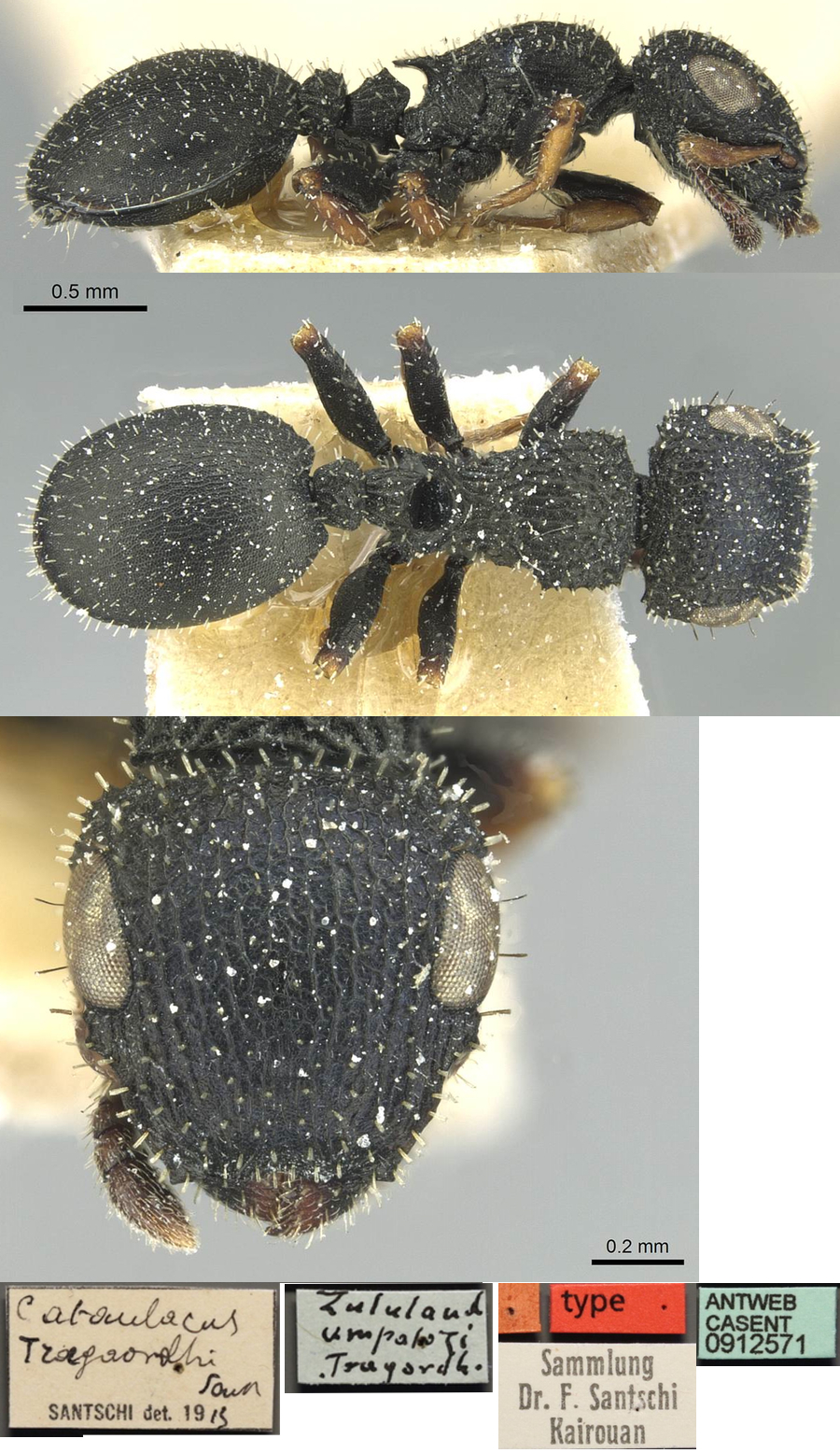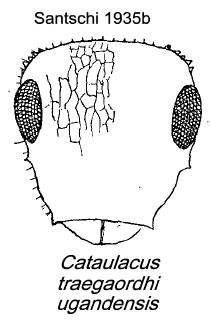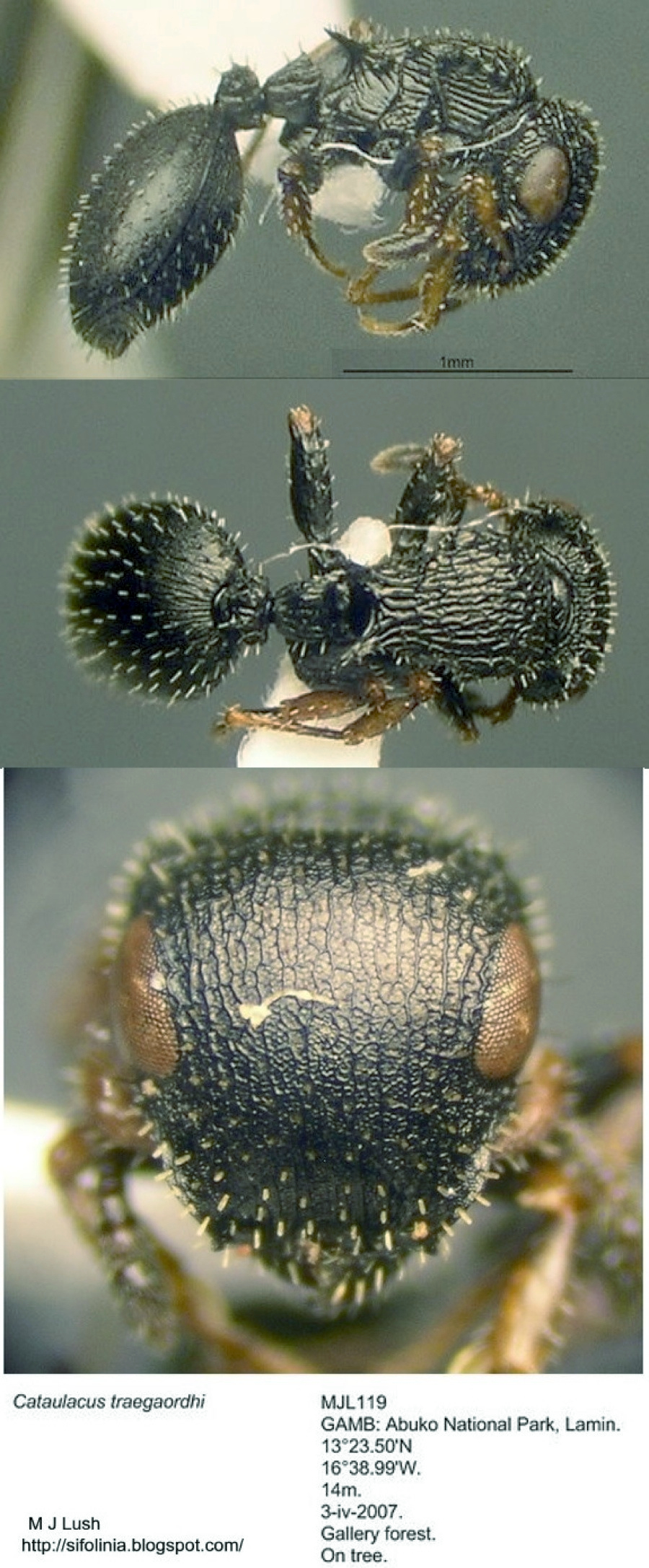Cataulacus traegaordhi Santschi
  Type location South Africa
(Cataulacus traegaordhi n.sp.,
Santschi 1914e: 24, illustrated, all forms) - see below Type location South Africa
(Cataulacus traegaordhi n.sp.,
Santschi 1914e: 24, illustrated, all forms) - see below
junior synonyms
marleyi
(Cataulacus Marleyi n. sp.,
Forel, 1914d: 219, worker; Arnold, 1917: 399, queen) from South
Africa - see http://www.antweb.org/specimenImages.do?code=casent0909227
suddensis (Cataulacus
pygmaeus E. André suddensis
subsp. nov., Weber, 1943c: 378, worker & male)
from Sudan - no images on Antweb (September 2014)
ugandensis (Cataulacus
trägårdhi Santschi var. ugandensis
nov., Santschi, 1914b: 110,
worker) from Uganda - see http://www.antweb.org/specimenImages.do?code=casent0912572.
Bolton (1982) lists it, without details,
as being known from Ghana, Nigeria and Cameroun;
plus Zaïre and numerous other sub-Saharan countries; all forms
known  . .
Revived from synonymy with Cataulacus
pygmaeus (as in Bolton, 1974a: 48) by Bolton (1982: 359) but
without fresh, full descriptions of either species. Thus, some of the
information below may refer to pygmaeus.
|
 Santschi's (1914e)
description is at Santschi's (1914e)
description is at  . Santschi's (1914b)
description of ugandensis
is at . Santschi's (1914b)
description of ugandensis
is at  . Arnold (1917: 399) gave
a translation, this is at . Arnold (1917: 399) gave
a translation, this is at  . Forel's (1914d) description of marleyi
is at . Forel's (1914d) description of marleyi
is at  . Arnold (1917: 398) gave
a translation of marleyi, with a description of the queen, this
is at . Arnold (1917: 398) gave
a translation of marleyi, with a description of the queen, this
is at  . Weber's (1943c)
description of suddensis (as pygmaeus ssp suddensis)
is at . Weber's (1943c)
description of suddensis (as pygmaeus ssp suddensis)
is at  . .
|
 The
photomontage of the type worker is collated from http://www.antweb.org/specimen.do?name=casent0912571 The
photomontage of the type worker is collated from http://www.antweb.org/specimen.do?name=casent0912571
|
Oxford University Museum
specimens
Cataulacus traegaordhi
B Taylor det. |
South Sudan
A Omer
S 1-12
|
2005-6
South Sudan
8.4666667° N
30.3166667° E
|
Thal Jath
|
1
|
 |
Cataulacus traegaordhi
B Taylor det. |
Benin
J-F Vayssieres
RVA 3096.9
|
9.xi.2011
Kika-Beterou
09°14'07'' N
02°11'52'' E
|
Isoberlinia doka
beating
|
1
|
 |
Cataulacus traegaordhi
B Taylor det. |
Cameroun
A Fotso Kuate
Cataulacus sp3
|
18.v.2007
Boga
03°54'30" N
11°25'58" E
|
Quadrat in fallow
|
1
|
 |
Cataulacus traegaordhi
B Taylor det.
|
Gabon
Y Braet
Gabon 110
|
7-8.viii.2006
Pongara
00°34' N
09°19' E
|
Sesame & forest,
sweep net
|
1
|
 |
|
 The
photomontage is of a specimen from South Sudan, from Thal Jath;
collector Awatif Omer, 2006 (Sudan 12). This appears
close to the original Santschi description and drawing. The
photomontage is of a specimen from South Sudan, from Thal Jath;
collector Awatif Omer, 2006 (Sudan 12). This appears
close to the original Santschi description and drawing.
|
 Nigeria specimens (as Cataulacus pygmaeus,
Taylor, 1979: 13). WORKER. TL 3.70-4.40 mm, HL 0.94-1.10, HW 0.92-1.06,
SL 0.48-0.52, PW 0.72-0.90 Nigeria specimens (as Cataulacus pygmaeus,
Taylor, 1979: 13). WORKER. TL 3.70-4.40 mm, HL 0.94-1.10, HW 0.92-1.06,
SL 0.48-0.52, PW 0.72-0.90
Occipital corners denticulate, with an adjacent second denticle. Sides
of head behind eyes denticulate. Sculpturation of head and dorsal
altitrunk a rugoreticulum, coarser on the alitrunk, tending posteriorly
to a fine irregular widely spaced rugation. Simple erect hairs on all
dorsal surfaces. Sides of alitrunk marginate especially strong on the
pronotum and denticulate throughout. Propodeal spines broad,
dorsoventrally flattened. Subpetiolar process variable sometimes with
the posteroventral angle acute, subpostpetiolar process short and
simple.
My collections were the first positive identifications
from Nigeria (at the Cocoa Research Institute of Nigeria, Idi
Ayunre, edge of Block W22, on a flower head). Although Eguagie (1971)
reported it, from Araromi near Ibadan, the specimens were not in the
CRIN collection nor seem to have been seen by Bolton (1974a); possibly
they were those listed under lujae in the later paper by Bolton
(1982).
|
|
 This appears, as with the specimen below, to be a match
for the Santschi (1935b) description of ugandensis, with the
broader head and finer sculpturation on the face; the shorter more
convex alitrunk; and, being generally shiner. This appears, as with the specimen below, to be a match
for the Santschi (1935b) description of ugandensis, with the
broader head and finer sculpturation on the face; the shorter more
convex alitrunk; and, being generally shiner.
|
 In the earlier
blanket consideration, Bolton (1974a)
described pygmaeus as mainly found in savannah and open wooded
areas, but also from forests. My findings of traegaordhi were
from low vegetation in unshaded areas at CRIN. It nests in stems or
twigs and will tend small coccids. I suspect that in West Africa this
is a species of open areas within forests and pygmaeus is from
tree savannah areas. The distribution outside West Africa, however,
suggests that the taxonomic situation is not fully resolved. In the
earlier list, under pygmaeus, there were findings from Liberia,
at Harbel (W.M. Mann); and Ivory Coast, near Abidjan (W.L.
Brown) but these records seem to have been lost in the 1982 paper. In the earlier
blanket consideration, Bolton (1974a)
described pygmaeus as mainly found in savannah and open wooded
areas, but also from forests. My findings of traegaordhi were
from low vegetation in unshaded areas at CRIN. It nests in stems or
twigs and will tend small coccids. I suspect that in West Africa this
is a species of open areas within forests and pygmaeus is from
tree savannah areas. The distribution outside West Africa, however,
suggests that the taxonomic situation is not fully resolved. In the
earlier list, under pygmaeus, there were findings from Liberia,
at Harbel (W.M. Mann); and Ivory Coast, near Abidjan (W.L.
Brown) but these records seem to have been lost in the 1982 paper.
The records from Mt. Nimba, Guinea, given by
Bernard (1952) as traegaordhi, came from both forest and
savanna locations. Workers were abundant in savanna (Kéoulenta and
Ziéla) but also from forest at N'Zo and Ravine 3 of Mount Tô (Camp II,
1500 m). Bernard commented on the discontinuous geographical
distribution of the (single) species, being common in Natal, Uganda and
Congo (Belgian, more rare) with the suprising banality at Nimba
(numerous workers, three queens and one male, collected by Lamotte).
The most common habitat was under bark and in twigs, as had been found
for the type collected by Traegaordh in Natal at around 2000 m (after
Bernard , 1952). The savanna records may well have been of Cataulacus
pygmaeus.
Taking the surmise of traegaordhi as a forest
species, it was collected by Room (1971) from on cocoa trees, plus on
the ground around the nest trees at the Mamfe-Mampong cocoa farm in Ghana.
His report includes reference to it nesting in cocoa canopy. It also
occurred in 63 of his 168 canopy samples at other farms and he
describes it as a highly specialized species distributed at apparent
random in relation to any of the dominant ants. In his studies of the
fauna of cocoa mistletoe (Room, 1972a, 1975), it was the second most
frequent insect on mistletoe plants, on the basis of presence/absence,
ranked 8th in occurrence at the cocoa/mistletoe junction (78 of 630
samples), but was only 20th in terms of abundance (185 individuals).
Curiously Bolton's (1974a) summary is at odds with Room's information.
Other Ghana records are from Accra (O.W. Richards), Larteh (D. Leston),
Pokoase and Koforidua (N.L.H. Krauss) (Bolton, 1974a).
The photomontage is of a specimen, appearing to match
the ugandensis form, from Gabon, Pongara National Park;
collector Yves
Braet (Gabon 110).
|
 The
photomontage is of a worker from Cameroun, Boga; collector A
Fotso Kuate (Cataulacus sp 3). The
photomontage is of a worker from Cameroun, Boga; collector A
Fotso Kuate (Cataulacus sp 3).
|
 The
photomontage is derived from that shown on http://sifolinia.blogspot.com/2007/10/cataulacus-traegaordhi.html,
taken by Mike Lush, Gambia, 3.iv.2007. The
photomontage is derived from that shown on http://sifolinia.blogspot.com/2007/10/cataulacus-traegaordhi.html,
taken by Mike Lush, Gambia, 3.iv.2007.
|
|